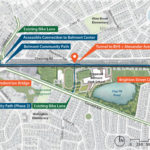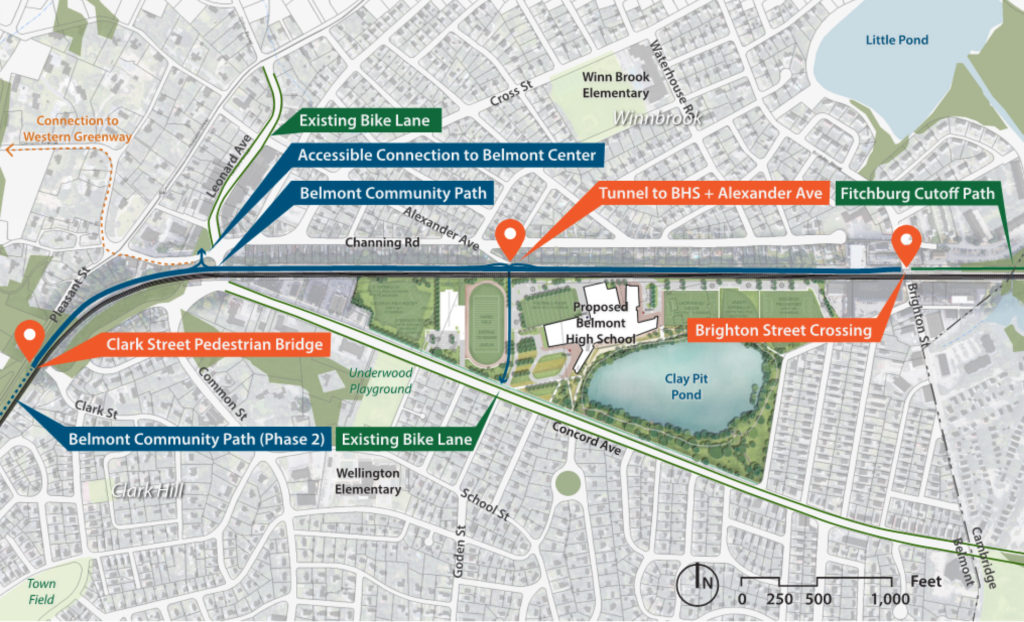
By Sara Smith, Jarrod Goentzel, and Eric Batcho
Momentum is picking up again for the Belmont Community Path, a critical two-mile link in the Mass Central Rail Trail (MCRT), a safe, off-road path that will ultimately link communities between Boston and Northampton. The 25% design is nearing completion, and the town has appropriated funds to begin securing the right of way. Both of these steps move Belmont closer to obtaining state and federal construction funds and bringing the path to fruition.
Community path 25% design phase
The town’s contractor, Nitsch Engineering, will complete the 25% design of Phase 1 in August or September. Phase 1 is the section of the path from Brighton Street to the Clark Street bridge just beyond Belmont Center, and includes a pedestrian underpass between the Winn Brook neighborhood and the new 7-12 school.
Nitsch states that it is incorporating comments received from abutters, the town, and the town’s Community Path Project Committee (CPPC) on the draft 25% design submitted in July 2020. Nitsch has also been gathering information about trees and utility locations along the tracks and is set to conduct the borings required to complete the Alexander Avenue underpass and retaining wall design, pending the availability of Keolis flaggers. Nitsch plans to submit the 25% design to the Massachusetts Department of Transportation (MassDOT) by September. MassDOT will hold a public hearing on the design shortly afterwards.
Funding for the design of Phase 1 has been supported by both a $150,000 grant from the state’s MassTrails team and $1.4 million previously allocated from the town’s Community Preservation Act (CPA) fund. This funding will cover the work through the 100% design on Phase 1.
Phase 1 right of way
The town is also responsible for securing the right of way (ROW) for the path, as defined by the 25% design. On June 7, Town Meeting voted by a wide margin of 200 to 50 to approve $200,000 of Community Preservation Act funds to begin the ROW process (tally at 2:54:50 of the recording). At that meeting (1:02.00), Russ Leino, chair of the CPPC explained that these funds will cover title and deed searches, appraisals of temporary easements for construction access, and potentially appraisal of a small number of permanent easements. The CPA funds are not intended for the purchase of these easements, though if money is left over it could be allocated for this purpose.
Last-minute controversy regarding a potential permanent easement at 40-42 Brighton Street was addressed when Nitsch Engineering confirmed that the path could be sited within the 13.8’ easement granted by the owner in 2008 to the Massachusetts Department of Conservation and Recreation for this purpose. In meetings ahead of the town meeting with Glenn Clancy, the town’s director of Community Development, the MBTA noted that the nine-foot clearance between the path and the track at this location is the minimum possible, but is feasible.
They also noted that placing the path on the south side of the tracks at this location would have been impossible due to only eight feet of clearance. It is also important to remember that a path on the south side at this location would have required an at-grade crossing of the active commuter rail line.
Phase 1 construction funding
Completing the 25% design and funding the ROW are key milestones toward being awarded construction funding through the federally-funded Transportation Improvement Program (TIP), a five-year budget administered by the Boston Metropolitan Planning Organization (MPO).
The MPO received over 350 letters of support for the path from the town and across the region when it considered the $16.7 million estimate for Phase 1 construction for the 2022-2026 TIP this spring. Letters cited benefits such as safety for students, new commuting options, recreation, stormwater upgrades, revenue generation in the town centers, and connections to neighboring paths. Cost increases for projects already in the TIP prevented the MPO from adding this path and many additional projects in this cycle.
In an encouraging response to letters, the MPO noted that “the robust enthusiasm for this project expressed by many stakeholders throughout this TIP cycle has been heartening.” The MPO formed a policy subcommittee to address cost increases and make more funding available for new projects in the 2023-27 budget planning next spring. With the completion of the 25% design and the ROW process underway, the path will be a strong candidate for construction funding in the TIP next spring.
Given that the Belmont Community Path is a top priority for the Governor’s MassTrails team, the TIP will likely fund construction costs. However, the TIP is just one of several funding sources committed to supporting this project. Last January, the Governor signed the Transportation Bond Bill that designated $7.5 million for the path. Also, Congresswoman Katherine Clark recently requested $3.5 million for path funding via the House Transportation and Infrastructure Committee.
Next steps
With the 25% design submitted and the ROW process underway, Nitsch will continue to engage stakeholders in finalizing the design of Phase 1. In this phase community members will be able to visualize the path through artistic drawings and consider specific design elements such as landscaping.
The town is also looking ahead toward Phase 2, the extension of the Belmont Community Path from Clark Street Bridge to the Waltham line where it will connect with the Wayside Trail. The town submitted another MassTrails grant application for design work (as it did to begin the design of Phase 1) and should have a response this summer. The two phases can move forward concurrently. In starting Phase 2 design now, the town would be well-positioned to complete the path through town soon after Phase 1 is finished.
Sara Smith, Eric Batcho, and Jarrod Goentzel are members of Friends of the Belmont Community Path. They can be reached at belmontpath@gmail.com.



Sorry, the comment form is closed at this time.